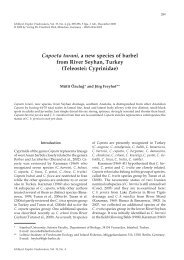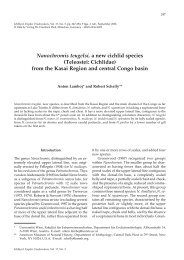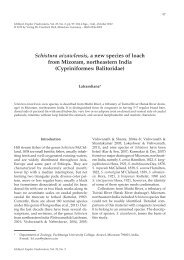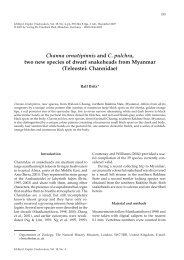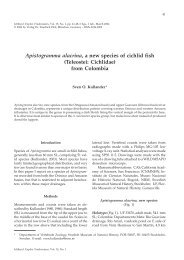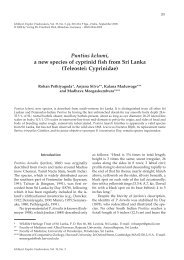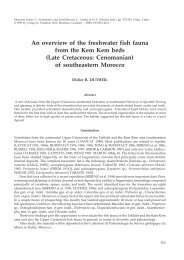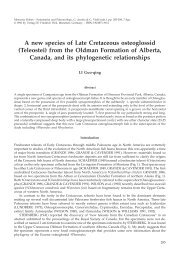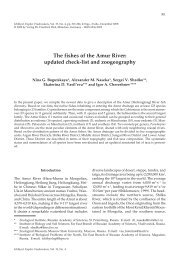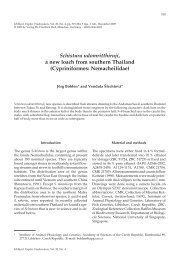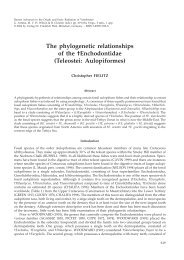A synopsis of the South Asian fishes referred to Puntius - Verlag Dr ...
A synopsis of the South Asian fishes referred to Puntius - Verlag Dr ...
A synopsis of the South Asian fishes referred to Puntius - Verlag Dr ...
Create successful ePaper yourself
Turn your PDF publications into a flip-book with our unique Google optimized e-Paper software.
80<br />
IO5<br />
IO4<br />
Pop<br />
IO3<br />
So<br />
IO1<br />
IO2<br />
a b c d<br />
Dawkinsia, new genus<br />
Type species. Leuciscus filamen<strong>to</strong>sus Valenciennes,<br />
in Cuvier & Valenciennes, 1844.<br />
Diagnosis. Dawkinsia differs from all <strong>South</strong> and<br />
Sou<strong>the</strong>ast <strong>Asian</strong> genera <strong>of</strong> Cyprinidae by <strong>the</strong><br />
combination <strong>of</strong> <strong>the</strong> following characters and<br />
character states: adult size usually 80-120 mm<br />
SL; rostral barbels absent, maxillary barbels<br />
present or absent; last unbranched dorsal-fin ray<br />
smooth (Fig. 8c); 4 unbranched and 8 branched<br />
dorsal-fin rays, 3 unbranched and 5 branched<br />
anal-fin rays; lateral line complete, with 18-22<br />
scales on body; gill rakers simple, acuminate (not<br />
branched or laminate); no antrorse predorsal<br />
spinous ray; free uroneural present (Fig. 8d); 4-5<br />
supraneurals; 15 precaudal and 14-17 caudal<br />
vertebrae; post-epiphysial fontanelle absent<br />
(Fig. 8b); infraorbital 3 slender, not overlapping<br />
preoperculum (Fig. 8a); juvenile (< 50 mm SL)<br />
colour pattern consisting <strong>of</strong> three black bars on<br />
body, persisting <strong>to</strong> adult stage in some species; a<br />
black, horizontally elongate blotch on <strong>the</strong> caudal<br />
peduncle in adults.<br />
Remarks. Based on <strong>the</strong> comparisons made herein,<br />
and <strong>the</strong> data <strong>of</strong> Taki et al. (1978) and Pethiyagoda<br />
& Kottelat (2005a), we include <strong>the</strong> following<br />
nine species in Dawkinsia: D. arulius (Jerdon, 1849),<br />
D. assimilis (Jerdon, 1849), D. exclamatio (Pethiyagoda<br />
& Kottelat, 2005b), D. filamen<strong>to</strong>sa (Valenciennes,<br />
in Cuvier & Valenciennes, 1844), D. rohani<br />
(Rema Devi, Indra & Marcus Knight, 2010), D. ru<br />
F<br />
Pa<br />
So<br />
PU3 PU2 CC<br />
Fig. 8. Dawkinsia filamen<strong>to</strong>sa, WHT 11026, 67.1 mm SL: a, circumorbital series; b, dorsal view <strong>of</strong> orbital region <strong>of</strong><br />
cranium; c, last unbranched dorsal-fin ray; and d, caudal skele<strong>to</strong>n (scale bar 1 mm). Abbreviations: CC, compound<br />
centrum; F, frontal; Ep, epural; H1-6, hypurals 1-6; IO1-5, infraorbitals 1-5; Pa, parietal; Ph, parhypural;<br />
Pls, pleurostyle; Pop, preopercle; PU2, PU3, preural centra 2, 3; So, supraorbital; Un, free uroneural;<br />
supraorbital sensory canal not shown.<br />
brotinctus (Jerdon, 1849) (see Knight et al., 2011),<br />
D. singhala (Duncker, 1912), D. srilankensis (Senanayake,<br />
1985) and D. tambraparniei (Silas, 1954).<br />
The genus appears <strong>to</strong> be restricted <strong>to</strong> Sri Lanka<br />
and sou<strong>the</strong>rn India.<br />
Etymology. The genus is named for Richard<br />
Dawkins, for his contribution <strong>to</strong> <strong>the</strong> public understanding<br />
<strong>of</strong> science and, in particular, <strong>of</strong> evolutionary<br />
science; gender feminine.<br />
Pethia, new genus<br />
Ep<br />
Pls<br />
Un<br />
H6<br />
H5<br />
H4<br />
H3<br />
H2<br />
H1<br />
Ph<br />
Type species. Barbus nigr<strong>of</strong>asciatus Gün<strong>the</strong>r,<br />
1868.<br />
Diagnosis. Pethia differs from all <strong>South</strong> and<br />
Sou<strong>the</strong>ast <strong>Asian</strong> genera <strong>of</strong> Cyprinidae by <strong>the</strong><br />
combination <strong>of</strong> <strong>the</strong> following characters and<br />
character states: small adult size (usually less than<br />
50 mm SL, exceptionally <strong>to</strong> 80 mm SL); rostral<br />
barbels absent; maxillary barbels usually absent,<br />
minute if present; last unbranched dorsal-fin ray<br />
stiff, serrated (Fig. 9c); 3 or 4 unbranched and 8<br />
branched dorsal-fin rays, 3 unbranched and 5<br />
branched anal-fin rays; gill rakers simple, acuminate<br />
(not branched or laminate); no antrorse<br />
predorsal spinous ray; infraorbital 3 deep, partially<br />
overlapping <strong>the</strong> cheek and preoperculum<br />
(Fig. 9a); free uroneural absent (Fig. 9d); 4 supraneurals;<br />
11-13 precaudal and 13-16 caudal<br />
vertebrae; post-epiphysial fontanelle absent<br />
(Fig. 9b); lateral line complete, interrupted or<br />
Pethiyagoda et al.: Synopsis <strong>of</strong> <strong>South</strong> <strong>Asian</strong> <strong>Puntius</strong>





